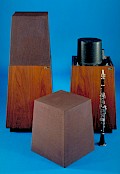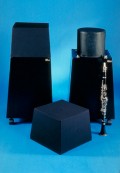In an effort to stiffen the spiders to a new, correct position on my Ohm F's, I'm thinking of applying DC voltage to each driver to move the spider into position and then apply ingerdients to re-stiffen them. This may be for a few days.
I see 1.8V, 0.31A is required to do this.
Is it fine to leave DC voltage to the voice coil for an extended period?
I see 1.8V, 0.31A is required to do this.
Is it fine to leave DC voltage to the voice coil for an extended period?
That is a VERY INTERESTING idea you've got ! Full marks for DIY 🙂
There should be absolutely no problem with constant DC of that amount.
What is the driver type you intend to do this with ?
( you may find the need for asymmetric application of added substance/ingredient )
There should be absolutely no problem with constant DC of that amount.
What is the driver type you intend to do this with ?
( you may find the need for asymmetric application of added substance/ingredient )
Last edited:
EXTRA >
The Ohm F was the most popular of the first generation Walsh speakers. It used a 12” inverted omnidirectional driver operating from 35 - 17,000 Hz. Some of the earliest Ohm Fs had Ohm A serial number plates, but the much smaller driver is of importance. The Ohm Fs were internationally recognized as ”one of the best…if… not the best…speaker in the world.” It received reviews from as far away as Australia and Thailand as well as throughout Europe and America.
Ohm F owners are a loyal group. Most find it hard to believe we’ve improved the speakers until they audition the top of the latest generation in their homes.
All Ohm Fs have reached the end of their functional lives. There is a foam damping material used around the base of the driver and inside that is failing from old age. We have never successfully repaired an Ohm F that was failing this way (the cone gets modified when you remove the old material and no longer sounds the same). For years, we replaced the old drivers with new ones. The last of these were made when the last craftsman retired. No more originals are available. But a series of upgrades with fourth generation drivers are available.
The Ohm F was the most popular of the first generation Walsh speakers. It used a 12” inverted omnidirectional driver operating from 35 - 17,000 Hz. Some of the earliest Ohm Fs had Ohm A serial number plates, but the much smaller driver is of importance. The Ohm Fs were internationally recognized as ”one of the best…if… not the best…speaker in the world.” It received reviews from as far away as Australia and Thailand as well as throughout Europe and America.
Ohm F owners are a loyal group. Most find it hard to believe we’ve improved the speakers until they audition the top of the latest generation in their homes.
All Ohm Fs have reached the end of their functional lives. There is a foam damping material used around the base of the driver and inside that is failing from old age. We have never successfully repaired an Ohm F that was failing this way (the cone gets modified when you remove the old material and no longer sounds the same). For years, we replaced the old drivers with new ones. The last of these were made when the last craftsman retired. No more originals are available. But a series of upgrades with fourth generation drivers are available.
It's just slightly more than half a watt. So any woofer voice coil should be able to dissipate that amount of heat without getting overheated.
Are you wanting to center it axially along the pole in relation to the top plate, or radially to the pole?
Because they are mounted horizontally and sag after time.why are they not correctly positioned?
Have a look:
https://www.audiosciencereview.com/forum/index.php?threads/ohm-walsh-speakers.8816/page-3
Then he should do as some manufacturers advice for large, heavy cones: remount them 180° from the last position once a year.
Was not there when I posted. Thought of other driver. So it is hanging down. Ask me about "down fire" and why I don't like it for a large driver.
Maybe just adjust the bass amp for some DC , so it doesn't matter in use? 😉
Seriously: There is a lot of talk and very little facts about "burn in" and "wear out" of speakers.
Some say after a while of use the single fibers in the suspensin break and you can only fix it by reconing.
In such a case I always check options. If reconing is an option, maybe go that way. The risk is that you get back a speaker with completely different TSP. Many people doing this "repair" don't care for parameter at all. They just glue in the cheapest stuff they can get.
A correct repair after 45 years would include new magnetizing and measuring TSP before and after. Tell me if you found such a shop. Good luck.
If reconing is a no go, consider a replacement woofer. Not the job the normal DIYS Joe can do.
If the chassis is a no repair anyway, I would consider heating up the spider, with a weight on the cone.
Last try to achieve the same could be some solvent or even clear coat, carefully applied to the spider with the cone in the correct position.
Using voltage to position the cone can backfire. If a solvent may work, it could soften the suspension too much and you would end with the cone too far on the other side... better fix some wood over the basket and statically adjust the cone position. Should be easy.
Maybe just adjust the bass amp for some DC , so it doesn't matter in use? 😉
Seriously: There is a lot of talk and very little facts about "burn in" and "wear out" of speakers.
Some say after a while of use the single fibers in the suspensin break and you can only fix it by reconing.
In such a case I always check options. If reconing is an option, maybe go that way. The risk is that you get back a speaker with completely different TSP. Many people doing this "repair" don't care for parameter at all. They just glue in the cheapest stuff they can get.
A correct repair after 45 years would include new magnetizing and measuring TSP before and after. Tell me if you found such a shop. Good luck.
If reconing is a no go, consider a replacement woofer. Not the job the normal DIYS Joe can do.
If the chassis is a no repair anyway, I would consider heating up the spider, with a weight on the cone.
Last try to achieve the same could be some solvent or even clear coat, carefully applied to the spider with the cone in the correct position.
Using voltage to position the cone can backfire. If a solvent may work, it could soften the suspension too much and you would end with the cone too far on the other side... better fix some wood over the basket and statically adjust the cone position. Should be easy.
1. Leaving them inverted with some weight inside the cone will work - eventually. I don't want to wait forever.
2. The foam issue: mine is in excellent shape with minimal "cracking". I want to try some silicone oil, as done to Apogee foam, to stabilize the remaning foam, without removing it. There are refurbishers who replace the foam. But I've always wondered if they test the frequency response to tweak the new foam to get the correct response; I doubt it.
3. Solvents: yes, I've read about that and it's an option if water doesn't work. I've also read that bakelite varnish was used back then for many spiders. So, an appropriate solvent for that should work. I'd rather buy a new spider and test solvents on that, getting it to submit to a new shape before I attempt it on the real thing.
4. DC voltage and heat: I agree, this is so small that heat is not an issue. The other issue with F's is that they used grease for haet disipation - many did. I see no sign of grease on my drivers. So, I wonder if they used ferrofluid. It's not readily apparent looking down at the gap. I may consider injecting some but have no idea what type.
5. Using other material to reposition: the driver is a cone. So, the only thing to use to push it down evenly is a sphere. Then the question is what part of the driver should it press against? Paper, aluminum or titanium? I want to avoid exerting pressure on any part of the driver and let the voice coil do the work - evenly and without any negative effect.
2. The foam issue: mine is in excellent shape with minimal "cracking". I want to try some silicone oil, as done to Apogee foam, to stabilize the remaning foam, without removing it. There are refurbishers who replace the foam. But I've always wondered if they test the frequency response to tweak the new foam to get the correct response; I doubt it.
3. Solvents: yes, I've read about that and it's an option if water doesn't work. I've also read that bakelite varnish was used back then for many spiders. So, an appropriate solvent for that should work. I'd rather buy a new spider and test solvents on that, getting it to submit to a new shape before I attempt it on the real thing.
4. DC voltage and heat: I agree, this is so small that heat is not an issue. The other issue with F's is that they used grease for haet disipation - many did. I see no sign of grease on my drivers. So, I wonder if they used ferrofluid. It's not readily apparent looking down at the gap. I may consider injecting some but have no idea what type.
5. Using other material to reposition: the driver is a cone. So, the only thing to use to push it down evenly is a sphere. Then the question is what part of the driver should it press against? Paper, aluminum or titanium? I want to avoid exerting pressure on any part of the driver and let the voice coil do the work - evenly and without any negative effect.
In this scenario I would be VERY hesitant regarding the use of solvents and solvent based products ~ even oils.
From my basic knowledge of Silicon Products, they come in 'neutral' & 'acetic' cure forms. Foam must be kept away from solvents.
Neutral cure products contain powerful solvents like MEK, so shouldn't be used near foam. Acetic cure is the only safe type.
I know nothing about "Silicone oil" except that it is a lubricant.
I would say be very careful AND good luck 🙂
From my basic knowledge of Silicon Products, they come in 'neutral' & 'acetic' cure forms. Foam must be kept away from solvents.
Neutral cure products contain powerful solvents like MEK, so shouldn't be used near foam. Acetic cure is the only safe type.
I know nothing about "Silicone oil" except that it is a lubricant.
I would say be very careful AND good luck 🙂
- Home
- Loudspeakers
- Planars & Exotics
- Re-center spiders in Ohm F: using DC voltage

